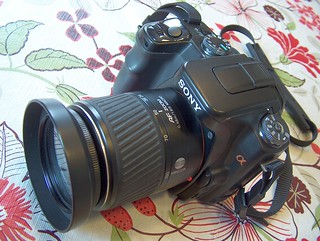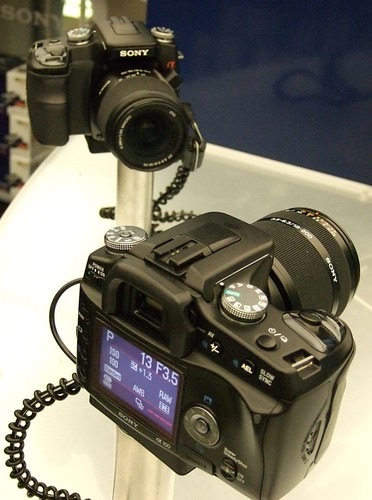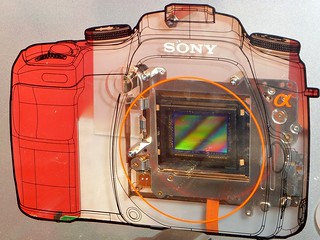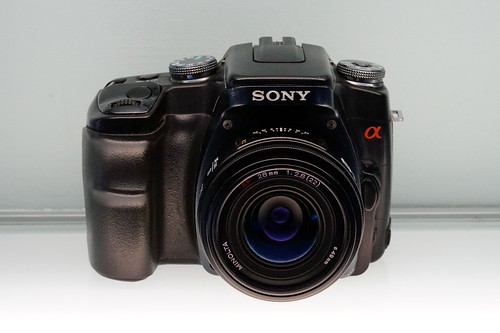Sony Alpha DSLR-A100
The Sony Alpha DSLR-A100 is the initial Sony-branded DSLR release after cooperation between Konica Minolta and Sony which began in autumn 2005. In winter 2005/2006 Konica Minolta decided to hand over all its assets related to DSLR technology to Sony.
The Alpha A-100 is Sony's first product in the modern SLR segment. It is the successor of the Konica Minolta Dynax 5D which had a similar antishake system introduced to DSLRs in Konica Minolta's 7D (initially introduced in Minolta's DiMage A1 "bridge" digital camera). The digital capture sensor is placed on the antishake-mechanism. The camera doesn't need special antishake lenses because shake-compensating movements are done by the sensor. All lenses for Minolta's 35mm autofocus SLRs can be used on the Sony camera body - the lens mount is Minolta's 1985 A-mount/Alpha-mount bayonet.
A dust removing system helps to keep the sensor clean. It shakes the sensor by means of the anti-shake mechanism. An improvement compared to the Konica Minolta DSLRs was the DRO setting, the Dynamic Range Optimization to make more details visible in shadow areas.

|
| with Minolta AF mount 28-100 zoom lens image by Gerard Vogels (Image rights) |

|
| Two Sony alpha DSLRs in the Sony Center (Berlin) image by Uwe Kulick (Image rights) |

|
| Sensor in "Super-Steady-Shot" frame image by Uwe Kulick (Image rights) |
Specifications

|
| with Minolta AF 28mm lens image by Jamo Spingal (Image rights) |
- Type: digital single lens reflex camera body
- Manufacturer: Sony [1] in Japan
- Factory: Konica Minolta production facility in Malaysia
- Year of launch: 2006
- Lens mount: Sony Alpha mount (was Minolta then Konica Minolta Alpha- or A-bayonet)
- Sensor: Sony Interlace scan CCD in APS-C format (23.6×15.8mm), 10.8 megapixels
- Metering: TTL (multi, spot, or center)
- Focusing: autofocus with four different modes
- Shutter: focal plane, controlled electronically, with speeds from 30 sec. to 1/4000 sec.
- Viewfinder: pentamirror finder, showing 95% of image, with diopter correction
- Display: 2.5 inch TFT, 230,000 color pixels
- Storage: CF CompactFlash card, Sony Memory Stick Pro via supplied adapter to CF
- Flash: built-in
- Weight: 545 g without rechargeable lithium-ions battery NP-FM55H
- Dimensions: 133×95×72mm
Notes
Links & References
| Japan Camera Grand Prix | |
|---|---|
| Camera of the year
1984: Nikon FA | 1985: Minolta α-7000 | 1986: Canon T90 | 1987: Canon EOS 650 | 1988: Kyocera Samurai | 1989: Nikon F4 | 1990: Canon EOS 10 | 1991: Contax RTS III | 1992: Pentax Z-1 | 1993: Canon EOS 5 | 1994: Minolta α-707si | 1995: Contax G1 | 1996: Minolta TC-1 | 1997: Nikon F5 | 1998: Pentax 645N | 1999: Minolta α-9 | 2000: Canon EOS-1V | 2001: Minolta α-7 | 2002: Canon EOS-1D | 2003: Canon EOS-1Ds | 2004: Nikon D70 | 2005: Konica Minolta α-7 Digital | 2006: Nikon D200 | 2007: Pentax K10D | 2008: Nikon D3 | 2009: Canon EOS 5D Mark II | 2010: Olympus Pen E-P1 | 2011: Pentax 645D | 2012: Nikon D800 | 2013: Sony DSC-RX1 | 2014: Nikon Df | 2015: Canon EOS 7D Mark II | 2016: Sony α7R II | 2017: Olympus OM-D E-M1 Mark II | 2018: Sony α9 | 2019: Lumix S1R | 2020: Sony α7R IV | 2021: Sony α1 | 2022: Nikon Z9 | 2023: Sony α7R V Special Prize Editor | |